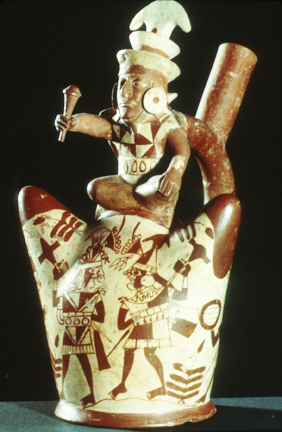
Fine line painted Moche stirrup spout vessel, from the Wari Valley, North Coastal Peru
Classic Period,400-900 CE
ART 198 - HISTORY OF WORLD CERAMICS
| Moche art coincidentally developed stylistic conventions very similar to the Egyptians: legs were painted in side view, the torso is frontal, the face is in profile, yet the eye is frontal. These characteristics can all be seen on this Moche stirrup spouted vessel. Moche pottery often portray warriors, combat, and the capture and sacrifice of prisoners. The warrior priest is always depicted as wearing a conical helmet and his body armor features a back flap. The depictions on Moche vessels are essentially realistic in that they portray the actual clothing, ornaments, and weapons that have been found in Moche burials. The distinctive stirrup spout is seen at the rear. The clay body used is a terra cotta color, and to this surface was painted a white or cream slip, then details were brushed in with a brick red slip. Much of the iconography seen on Moche vessels is of unclear meaning because, unlike the Maya to the north, the Moche had no written language. Music was played at both religious and secular ceremonies, and instruments were often made of clay, including the flute, bugle and rattle. Conch shells were also used as musical instruments. Most Moche pottery has been excavated from tombs, but it often shows signs of use before burial. | Fine line painted Moche stirrup spout vessel, from the Wari Valley, North Coastal Peru Classic Period,400-900 CE |
|
|